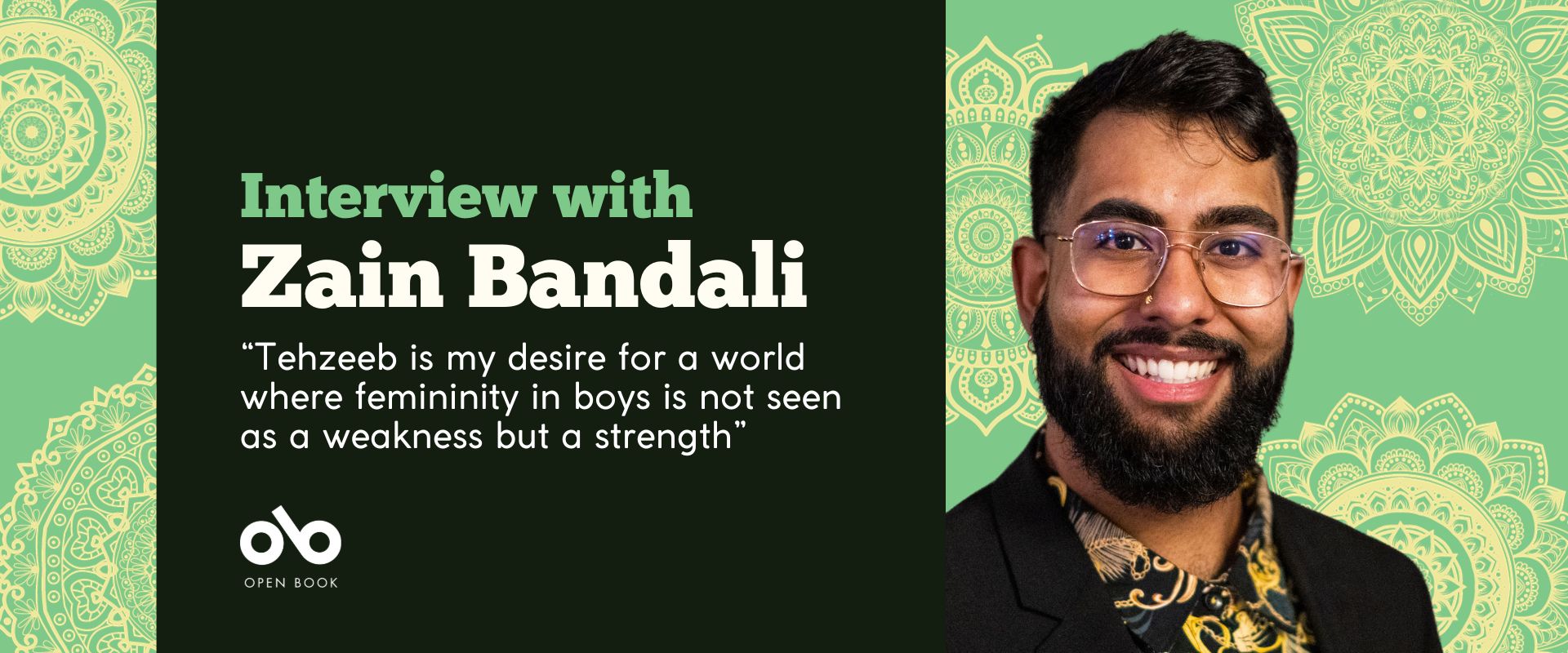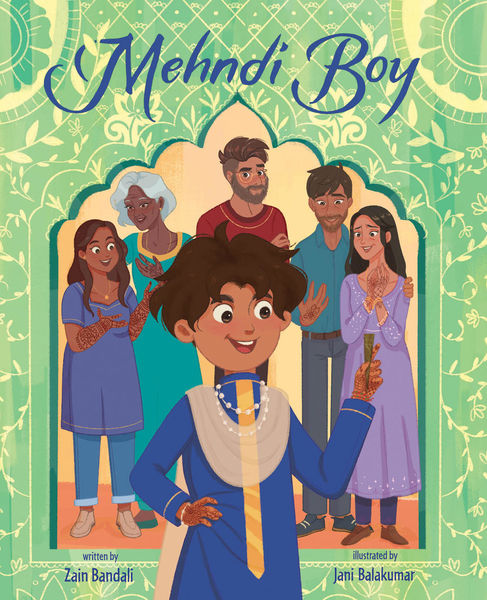Zain Bandali Uses Mehndi to Talk About Gender, Creativity, and Being Your True Self in His Delightful Debut
In Zain Bandali's Mehndi Boy (Annick Press), Tehzeeb loves to draw. He practices his clouds, patterns, stars, and more, as whole galaxies of beautiful and intricate designs swirl across his notebooks. When he gets to try out his designs with mehndi, a temporary skin decoration created with henna, he knows he's found his passion.
Then his beloved uncle pulls him aside and delivers crushing news: Tehzeeb can never be the mehndi artist he dreams of becoming. Because mehndi is for girls.
Heartbroken and confused, Tehzeeb wants to listen to his uncle but the pull of mehndi on his heart can't be ignored. And when his cousin finds herself in desperate need of a mehndi artist just hours before her wedding, Tehzeeb is presented with the perfect opportunity to be his authentic self and share his talent – even if is means standing up for his passion to his family and community.
In Bandali's hands, Tehzeeb's character is pure charm from the first page, and the story thoughtfully explores family pressure, tradition, creativity, and identity, while Jani Balakumar's stunning artwork bring readers into Tehzeeb's world and imagination. The book even includes resources and activities for young readers to learn more about mehndi.
We're speaking with Zain today as part of our Kids Club series, to celebrate the publication of Mehndi Boy.
He tells us about the role the Annick Press Mentorship Program, played in the book's creation, how his own childhood love of mehndi informed the story's origins, and how Tehzeeb represents his desire for a world "where stubborn gender norms are not what dictates what a child may do or learn."
Open Book:
Tell us about your new book and how it came to be.
Zain Bandali:
Mehndi Boy is a story about a young boy named Tehzeeb and his fascination with mehndi, also known as Henna. From the moment he tries it on at his cousin’s engagement, he is absolutely transfixed by the ancient art form and brings it everywhere he goes. Soon, he’s practicing on his classmates and neighbours and anyone that will lend him their hand — earning him the new nickname: Mehndi Boy!
However, not everyone is thrilled with his new artform — Tez’s favourite uncle thinks mehndi isn’t for boys. His art brings people joy. How could it be wrong? Tehzeeb doesn’t want to disappoint his uncle. But when a crisis before his cousin’s wedding puts his talents to the test, Tehzeeb must find the courage to be his true creative self. Mehndi Boy follows Tehzeeb as he stands up for himself and defends his artform, navigates anxiety, and overcomes perfectionism — all while pushing stubborn gender norms in a kid friendly way.
I had always wanted to write a book for children, but for a long time nothing came of it. It wasn’t until 2021 that I applied for the Annick Press Mentorship Program, which prompted me to revisit my desire to write again. I submitted an outline, and I had the good fortune of being selected out of the few hundred applicants! As a mentee, I was given the chance to develop my outline into a manuscript with the help of my editor, Claire Caldwell. By the end of the mentorship program, I was offered a contract! The next two years were filled with lots of edits, fine tuning the text, and working with my illustrator Jani Balakumar to bring my story to life! Last month, Mehndi Boy was finally published!
Your CanLit News
Subscribe to Open Book’s newsletter to get local book events, literary content, writing tips, and more in your inbox
I am pleased to share that Mehndi Boy was nominated for the Silver Birch Express Award, a part of The Forest of Reading®, Canada’s largest recreational reading program that encourages a love of reading in people of all ages. This allows Mehndi Boy to be in the hands of grade 3 and 4 students across Canada, celebrating my vision of sharing my cultural heritage with young readers.
OB:
Is there a message you hope kids might take away from reading your book?
ZB:
Fundamentally, the message I am trying to bring forth is this idea that: art is art. Like painting or drawing, mehndi is art. A child should feel encouraged to be artistic and explore their creativity in whatever way inspires them — no matter of their gender. How might the world be a better place if boys were encouraged to be exactly who they wanted to be? Where their softness is respected, where their femininity is nurtured and honoured? For me, it begins with the permission that they too can sport a flower on their hands and the encouragement that they too can be mehndi artists.
OB:
Did the book look the same in the end as you originally envisioned it when you started working, or did it change through the writing process?
ZB:
The book in its final form is brilliant and blew my initial expectations out of the water. I am so grateful for Jani Balakumar’s emotive and stunning illustrations. With that being said, I originally conceived Mehndi Boy as a picture book when I first submitted my outline to the Annick Press Mentorship Program. It was after working with my editor Claire Caldwell that it was suggested that my writing style and the storyline would better lend itself to an early reader chapter book. This decision enabled me to still have gorgeous illustrations throughout, but also finetune the text to a slightly older age group.
OB:
Is there a character in your book that you relate to? If so, in what ways are you similar to your character and in what ways are you different?
ZB:
Tehzeeb represents the aspirations of my inner child. His creativity, boldness, and relentless desire to be exactly who he is — is something I displayed as a child. The difference is Tehzeeb early on is met with nurturing figures who encourage his artistry early on — something I did not have when it came to my own love for mehndi. Tehzeeb is my desire for a world where femininity in boys is not seen as a weakness but a strength. Where stubborn gender norms are not what dictates what a child may do or learn, but their intrinsic interests do.
OB:
What do you need in order to write — in terms of space, food, rituals, writing instruments?
ZB:
Mehndi Boy was written during the peak portion of the pandemic while I also balanced a full-time 9-5 day job as I worked from (my parents’) home. It was an incredibly difficult time for me personally, and it was absolutely a challenge I had to grapple with. What helped was using an extra day or two of vacation days alongside weekends to devote a couple hours to writing. That way, you give yourself some time to mentally transition to your creative mindset, when your mental energy is otherwise being siphoned into a corporate job. Rest and space was paramount to enabling those creative juices to flow.
When the weather was cooperating, I often found myself working in my backyard. I’d often light an incense stick, agarbatti, make myself a cup of chai, and sit with a warm shawl. This enabled me to change the scenery and open myself to be inspired by the flora, fauna, and other natural elements just steps outside my home.
OB:
What was the strangest or most memorable moment or experience during the writing process for you?
ZB:
One of the most thrilling moments for me was seeing the character sketches shared with me for the first time. It is such a monumental occasion, seeing someone else represent what you up until that point only pictured in your mind. Illustrations truly enhance the text in such a meaningful way, and I remember the feeling of newness and yet simultaneously deep familiarity. Tehzeeb and other characters came to life for me that day, and it was one that I’ll always cherish. I am once again so grateful to Jani Balakumar for her gorgeous illustrations, she truly made Mehndi Boy the eye catching chapter book it is today.
____________________________________________________
Zain Bandali is an unapologetic Ismaili Muslim queer artist of Indo-Tanzanian heritage living in Ontario, Canada. He writes on themes related to mysticism, queerness, diasporas, and where they interact. His poetry has been published in multiple journals and his spoken word has graced stages across the province. He is an avid vegetable gardener but cannot always stomach the chilli peppers he grows.





